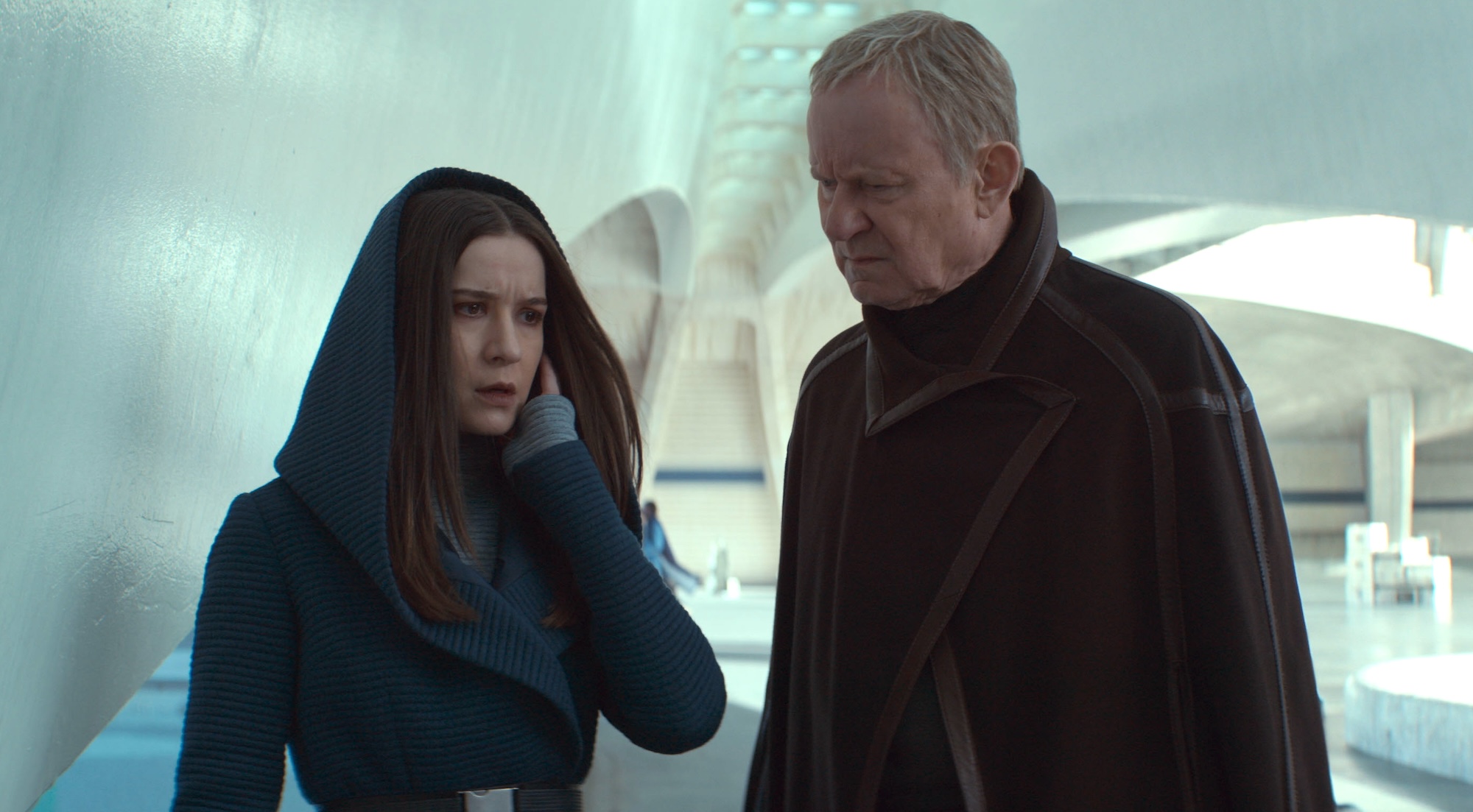This past weekend, I participated in the No Kings March in Manhattan. Despite rain and unusually cool weather for mid-June, the event at times felt like a cathartic exorcism—or at least a deep sigh of relief after long-simmering despair. It also acted as an exercise in civic duty for a hundred thousand or so likeminded New Yorkers. And during the otherwise familiar proceedings of peaceable assembling and civil strolling, there was a curious novelty I did not anticipate: a kind and determined woman passing out signs that read “I Have Friends Everywhere.”
The cryptic line is from the latest and final season of Andor, Tony Gilroy’s unapologetically sophisticated portrait of what a rebel alliance might actually look like if it were to resist sweeping imperial power (emphasis on the alliance aspect). In the Star Wars series, cagey spymaster Luthen Rael (Stellan Skarsgård) uses this same turn of phrase as a signal for the ephemeral power of his network of informers, spies, and dissidents, as well as a way for one rebel to tip their motivations to another. It also takes on bitter irony in the show since Luthen, in his lifetime of double-dealing and political paranoia, comes to believe he actually has no real friends at all. He even asserts there will be no sunrise for him, which has a tragic irony for anyone who knows where the Star Wars saga and its scrappy rebels’ journey is headed.
Of course Andor is not the first piece of pop culture detritus to be incorporated by a political movement in our own galaxy. I’m old enough to remember when the so-called resistance during the first Trump administration cut out signs quoting Lin-Manuel Miranda’s Hamilton, asserting that “history has its eyes on you,” (mistakenly believing the leaders of that regime cared anymore than the “America First” brownshirts of nearly a hundred years ago did about how history would judge them). Conversely, there was that time in 2009 when Tea Party activists protested against Obamacare by likening the 44th president to Heath Ledger’s Joker in The Dark Knight.
What is perhaps more interesting for the purviews of this article, then, isn’t that politically frustrated citizens see themselves as ragtag rebels; it’s that something produced under the largely innocuous umbrella of Lucasfilm in its Disney era has created a new piece of pop culture relevant enough to feel vital to the conversation of right now. Because despite Gilroy’s claims in the press that he views Andor’s story as apolitical—even as he is clearly pulling from historical contexts as varied as the Jallianwala Bagh massacre in India in 1919 to the Peterloo slaughter in the UK’s own Manchester backyard in 1819–there is an undeniable urgency to the way the Ghorman Massacre is carried out in the Star Wars series, right down to the equivalent of imperial space cable news conditioning the populace to view the violence as instigated by protestors who were invaded by outside agitators. As Sen. Mon Mothma eerily puts it in a speech that gains her an arrest warrant, “The distance between what is said and what is known to be true has become an abyss.”
Whether by fluke or (absolutely obvious) design, Andor is a series made of its moment, and it marks the first time the Star Wars brand has contributed something fresh and engaged with the cultural zeitgeist since George Lucas hung up his lightsabers 20 years ago.
To be clear, this is in no means to say that Gilroy’s series is the most popular thing Disney has made in the Star Wars sandbox. Not even a full decade ago, Star Wars: The Force Awakens grossed over $2 billion worldwide. And as fetching as Diego Luna and Adria Arjona are, we doubt their likenesses will move nearly as many dolls as Grogu, a pint-sized mascot that fans simply knew for years as “Baby Yoda.”
And yet, that same Yoda resemblance is also a reminder of how so much of Disney’s Star Wars is built solely off reminding you of movies that are approaching their 50th birthdays. It was even initially sold as a feature instead of a bug when Adam Driver stared covetously at Darth Vader’s helmet—at least until audiences realized that such worshipfulness didn’t add up to much more than a fanboy’s fixation on the past.
Whereas the original Star Wars trilogy represented a synthesis of every film, serial, and pulp novel that captured a young George Lucas’ fancy once upon a time, the only thing modern Star Wars has seemed content with conversing with is… more Star Wars from a long, long time ago. The approach led to massive financial success, especially as a few filmmakers attempted to color outside the lines, but ever since the online backlash toward Star Wars: The Last Jedi seven years ago, the franchise has simply settled for reliving past glory days—and thus having nothing particularly interesting to contribute to today beyond echoing when James Earl Jones purred, “No, I am your father” or endless homages to Harrison Ford’s scoundrel smirk and John Williams’ imperial march.
Perhaps the one exception in the modern era that proved partially impervious to this critique was the film from which Andor sprang: Rogue One: A Star Wars Story. That movie is ostensibly directed by Gareth Edwards, but was largely rewritten and restructured by Gilroy. And that structure was based on what the Michael Clayton scribe called “a Battle of Britain” sensibility. By this he meant a sense of genuine RAF-inspired sacrifice during the UK’s darkest hour in the Second World War. He recalled better than most that Lucas leaned heavily on WWII melodramas of the 1940s and ‘50s for inspiration while making the original Star Wars, but Gilroy went beyond that and actually remolded Rogue One around actual wartime espionage and subterfuge.
That film is certainly far from perfect, having the fingerprints of a picture that was tinkered with extensively in post-production. (By several accounts, Gilroy reshot more than a third of the picture and added the tragic bent that pervades the finished film.) It also is still dripping with fan-servicing nostalgia, including when Darth Vader shows up long enough to eviscerate some ‘70s-clad rebels. But it worked well enough in 2016 and works even better in 2025 after Andor smoothed out the rough edges by giving gravity and context to Luna’s broadly sketched rebel assassin, as well as to the entire political and logistical infrastructure of a Rebel Alliance that, previously, were simply “the good guys.”
This is in large part accomplished by heightening and expanding on the real-world influences, including of the 1940s variety with the resistance on the planet Ghorman not so subtly resembling the French Resistance, who likewise were asked to sacrifice frequently their last full measure in order to see a day where they were not occupied by the Third Reich and a compliant, collaborative local government out of Vichy.
But much of the reason Andor works as well as it does—in addition to sharp dialogue, on-location shooting, and crackling performances—is because Gilroy made the choice to echo the real historical cycles of autocracy, oppressive overreach, and destabilization with the kind of zeal Lucas applied to emulating Akira Kurosawa and John Ford. One approach is not better than the other, but both are determined to introduce new toys to the space opera playground, as opposed to playing the same games for half a century and counting.
The result is that for those who watched Andor, Star Wars as a concept feels exciting and contemporary—and by extension it makes Rogue One and the original movie (A New Hope) more satisfying as well. In addition to the “I Have Friends Everywhere” signs blinkering New York this past weekend, I also saw shirts with the line “Rebellions Are Built on Hope,” a catchy phrase in Rogue One that was expanded upon in Andor, and now is as much a Star Wars quotable as “may the Force be with you.”
Andor has elevated Rogue One and furthermore built a sizable corner of the canon that seems destined to last. Who really knows if anyone will be watching Andor in 10 or 20 years, or if they’ll still be talking about “rebellions” and “hope,” but I suspect so. With the last breaths of Kathleen Kennedy’s tenure of leading Lucasfilm, she has at last been able to allow creatives the space to build something looking toward the future instead of the past. As a consequence, this galaxy again has some significance in our present. For Star Wars, that amounts to a new hope unto itself.
The post Andor Is Making Star Wars Culturally Relevant Again appeared first on Den of Geek.




